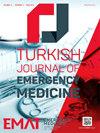Manual versus mechanical chest compression in in-hospital cardiac arrest: A retrospective cohort in emergency department patients
IF 1.1
Q3 EMERGENCY MEDICINE
引用次数: 0
Abstract
OBJECTIVE: Mechanical chest compression (CC) devices are frequently used in in-hospital and out-of-hospital settings. In this study, mechanical and manual CC in in-hospital cardiac arrest was compared in terms of survival. METHODS: Adult patients who were admitted to the emergency department (ED) for 2 years period and had cardiac arrest in the ED were included in this retrospective, observational study. Return of spontaneous circulation (ROSC), 7-day and 30-day survival and hospital discharge data were compared between the two groups of patients who underwent manual CC and those who had mechanical CC with the Lund University Cardiac Assist System-2 device. RESULTS: Although the rate of ROSC in the mechanical CC group was lower than in the manual CC group, this difference was not statistically significant (41.7% vs. 50.4%; P = 0.133). The 7-day survival rate was found to be statistically significantly higher in the mechanical CC group (19.4% vs. 8.9%; P = 0.012). The 30-day survival rate was also found to be high in the mechanical CC group, but this difference was not statistically significant (10.6% vs. 7.3%; P = 0.339). CONCLUSION: In the light of these results, we can say that the use of piston-based mechanical CC devices in ED may be beneficial. More reliable results can be obtained with a prospective study to be performed in the ED.手动与机械胸外按压在院内心脏骤停:回顾性队列急诊科患者
目的:机械胸外按压(CC)装置在医院内外的应用非常广泛。在这项研究中,比较了院内心脏骤停患者的机械和手动CC的生存率。方法:回顾性观察性研究纳入了在急诊科(ED)住院2年并在ED发生心脏骤停的成年患者。比较两组患者的自发循环恢复(ROSC)、7天和30天的生存和出院数据,这两组患者分别采用隆德大学心脏辅助系统-2装置进行手动CC和机械CC。结果:虽然机械CC组ROSC发生率低于手动CC组,但差异无统计学意义(41.7% vs 50.4%;P = 0.133)。机械CC组7天生存率显著高于机械CC组(19.4% vs. 8.9%;P = 0.012)。机械CC组的30天生存率也较高,但差异无统计学意义(10.6% vs. 7.3%;P = 0.339)。结论:基于这些结果,我们可以说在ED中使用活塞式机械CC装置可能是有益的。在急诊科进行前瞻性研究可以获得更可靠的结果。
本文章由计算机程序翻译,如有差异,请以英文原文为准。
求助全文
约1分钟内获得全文
求助全文
来源期刊

Turkish Journal of Emergency Medicine
EMERGENCY MEDICINE-
CiteScore
1.70
自引率
0.00%
发文量
30
审稿时长
22 weeks
期刊介绍:
The Turkish Journal of Emergency Medicine (Turk J Emerg Med) is an International, peer-reviewed, open-access journal that publishes clinical and experimental trials, case reports, invited reviews, case images, letters to the Editor, and interesting research conducted in all fields of Emergency Medicine. The Journal is the official scientific publication of the Emergency Medicine Association of Turkey (EMAT) and is printed four times a year, in January, April, July and October. The language of the journal is English. The Journal is based on independent and unbiased double-blinded peer-reviewed principles. Only unpublished papers that are not under review for publication elsewhere can be submitted. The authors are responsible for the scientific content of the material to be published. The Turkish Journal of Emergency Medicine reserves the right to request any research materials on which the paper is based. The Editorial Board of the Turkish Journal of Emergency Medicine and the Publisher adheres to the principles of the International Council of Medical Journal Editors, the World Association of Medical Editors, the Council of Science Editors, the Committee on Publication Ethics, the US National Library of Medicine, the US Office of Research Integrity, the European Association of Science Editors, and the International Society of Managing and Technical Editors.
 求助内容:
求助内容: 应助结果提醒方式:
应助结果提醒方式:


